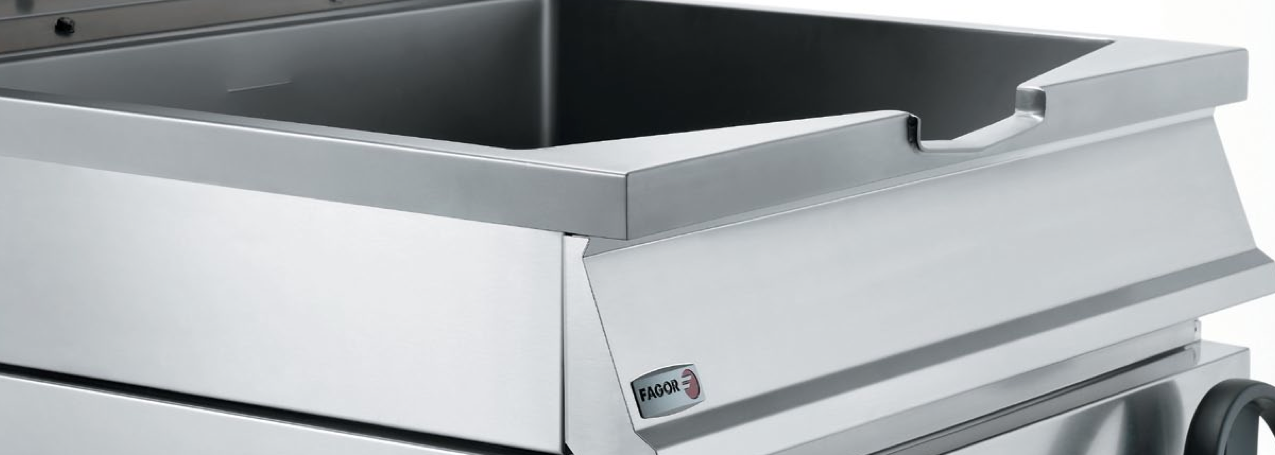In recent weeks we have talked about chill blasters, the ADVANCE ovens or the conveyor belt dishwashers, which are all essential elements for the professionals who work in the kitchen of a big restaurant, a hotel or a hospital, but you may have asked yourself at times: what is the machinery for kitchens and laundries made out of?
In the catering world materials play a very important role; professionals want their kitchens to be equipped with resistant and long-lasting machinery capable of withstanding working days for many years.
As regards equipment, we must point out that stainless steel continues to be the star. It is a resistant element that guarantees the use of installations for many years. This is perhaps something that is taken for granted, but for professionals it is a really important element due to the investment it represents in an installation of these characteristics.
The main elements that take part in the composition of stainless steel are iron, chrome, nickel, carbon and manganese. The percentage of these elements and their variation gives rise to different types of stainless steel:
- Martensitic stainless steel: These stainless steels are essentially alloys of chrome and carbon and have the common characteristic of being magnetic and that can be hardened by thermal treatment. The most used martensitic stainless steel is AISI-420 (13% Cr, 0.35% C).
Characteristics:
• Moderate resistance to corrosion
• High levels of mechanical resistance and hardness
• Due to the high carbon content and the nature of its hardness, it is difficult to weld
• Magnetic
Applications: cutlery, brake disks, surgical equipment, dental equipment and turbines.
- Austenitic stainless steel: Austenitic steels are obtained incorporating austenite forming elements, such as nickel, manganese and nitrogen. The chrome content generally varies from 16 to 26% and its carbon content ranges from 0.03 to 0.08%. The high content in chrome provides resistance to oxidation in temperatures of around 650 °C in a variety of environments.
We can distinguish two main categories in this family of steels:
Austenitic Stainless Steels Al Cr-Ni (Series 300)
Characteristics:
• Very good resistance to corrosion
• Excellent weldability and ductability
• Easy transformation
• Excellent hygiene and cleaning factor
• They are not magnetic
Applications: cutlery, dishes, sinks, catering machinery, lift cladding and in many other applications.
Austenitic Stainless Steels Al Cr-Ni-Mn (Series 200)
Characteristics:
• High end hardness
• Excellent weldability and ductability
• Excellent forming
• Good resistance to corrosion in normal corrosive environments
• Very good response to deep-drawing
• They are not magnetic
Applications: food machines, extractors, units and machinery for the kitchen, etc. - Ferritic stainless steel: Ferritic steels are essentially alloys such as chrome, but may contain molybdenum, silica, aluminium, titanium and niobium, which gives them different characteristics and performances.
Characteristics:
• Moderate to good resistance to corrosion in normal corrosive environments
• Little resistance to impact
• They are magnetic
• It is hard to weld, and therefore the joints from welding at thin qualities are reduced.
• Stampability is good, although insufficient if deep stamping is required.
Applications: cutlery, dishes, machinery for kitchens, sinks, coins, stainless claddings, counters, bars, refrigerated cabinets, etc. - Duplex stainless steel (austenitic-ferritic): Duplex stainless steels have a microstructure that contains austenite and ferrite. They are chrome-nickel-molybdenum alloys, with a chrome content of 18 to 26% and of nickel of 4.5 to 6.5%.
Characteristics:
• They cannot be hardened by thermal treatments
• Good weldability
• Very good mechanical resistance
• Very good resistance to corrosion
• They are magnetic
Applications: growing use in the chemical and oil by-product industry, and in specific energy generation applications, pulp and paper industry, etc. - Stainless steel hardened by precipitation: This family offers an alternative to austenitic stainless steels when associating high mechanical characteristics with an easier mechanisation is required. They are iron-chrome-nickel alloys that are characterised by the mechanical resistance obtained from hardening by thermal ageing treatment. Steels that can be hardened by precipitation are usually patented and they are usually marked with the initials of the producing company.
Stainless steel provides added value over other materials, and allows very good hygienic conditions, something that is essential in the establishments of the Horeca sector.



Follow us